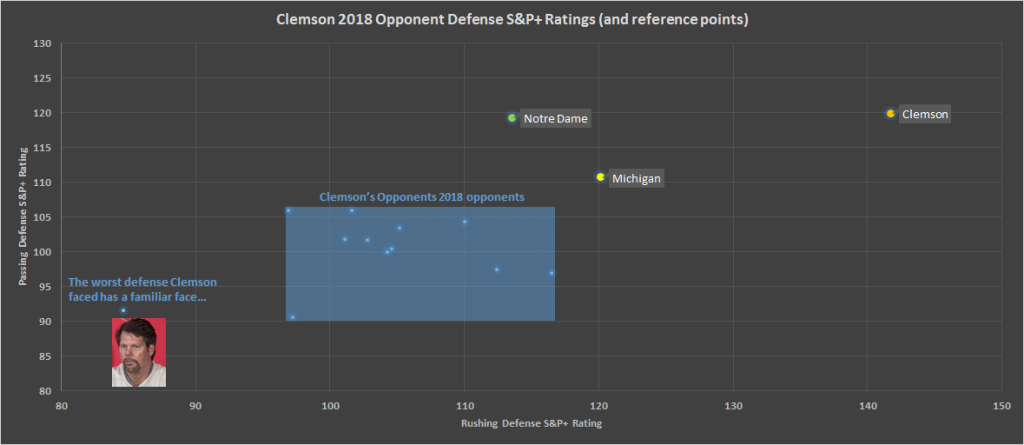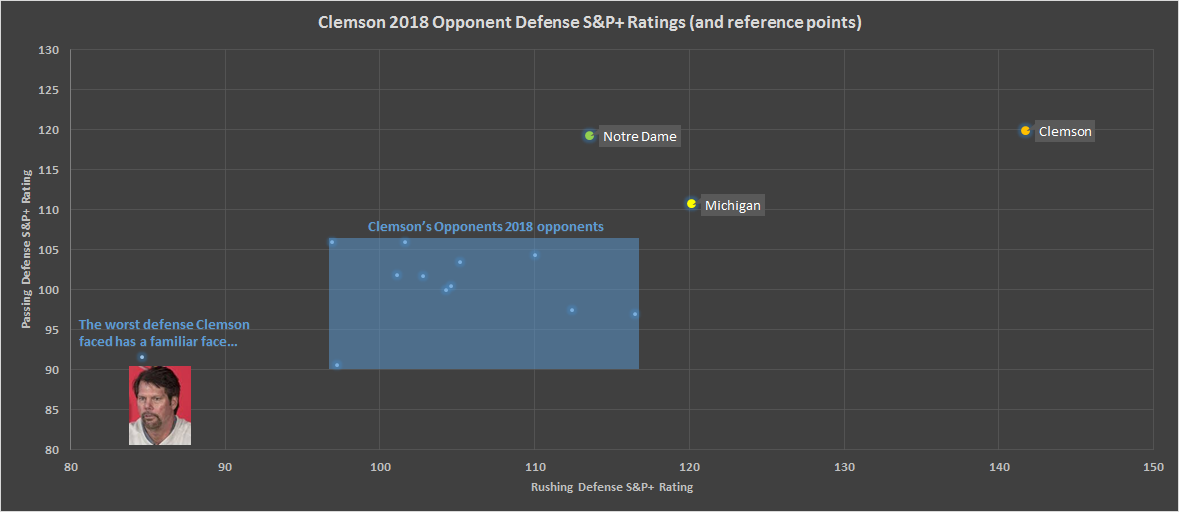They’ve been great on paper, but they haven’t faced a top-10 opponent like this in 2018. That statement applies to both the Clemson offense and Notre Dame defense, as both will raise the difficult setting considerably in the Cotton Bowl. Why Clemson’s efficiency is underrated and will test Clark Lea’s “bend but don’t break” defense, and how the Irish may field their best defense of the year in Arlington.
Missed the Notre Dame offense versus Clemson defense preview? It’s here.
Confused? Check out the advanced stats glossary here or holler at me in the comments.
A Notre Dame defense that seldom bends, doesn’t explode, and hardly ever breaks
For as terrific as Ian Book has been since taking over at quarterback, the best piece of this Notre Dame team for the entirety of 2018 has been the defense. The Irish enter the playoff ranked 4th in Defensive S&P+, and have been strong in every imaginable situation. Clark Lea’s unit is top-25 in run defense (18th), pass defense (8th), limiting efficiency (23rd), limiting explosiveness (5th), standard downs defense (15th), and passing downs defense (7th).
The balance is extremely impressive, and enables the Irish to play an extremely effective bend but don’t break defense as the default. Notre Dame hasn’t even bent all that much – they finished the regular season 18th in opponent success rate – but simply refuses to give up long plays, finishing 3rd in marginal defensive explosiveness. ND hasn’t allowed a gain longer than 60 yards this year, and allowed just five of 40+, tied for fourth nationally.
Armed with the most talented defensive line since at least 2012, the Irish dared less talented opponents to string together long drives, and they were rarely up to the task. On the infrequent occasions when opponents were able to sustain possessions, the defense clamped down when it mattered most, allowing just 3.27 points per scoring opportunity (1st down inside the Irish 40), 3rd best in FBS.
A balanced Clemson attack raises the difficulty setting
It shouldn’t come as a surprise – it’s the playoffs after all – but the Irish defense also hasn’t seen anything like Clemson’s offense. Per S&P+, the best offenses ND faced this season were #22 Stanford, #24 Michigan, and #44 Syracuse, and #45 Vanderbilt (not a typo). In almost every matchup the Notre Dame defense had a clear weakness to exploit or divert resources away from to where there was a greater need. The Cardinal offense reversed their stereotypical manball profile with a dangerous pass attack but an ineffective run game. Michigan is the closest resemblance to a balanced offense, but was dominated in the trenches and didn’t run or pass well. Multiple teams down the stretch –notably Syracuse, FSU, and USC – the Irish dared to run well enough and often enough to win, and weren’t up to the task.
| ND Opponent | Rushing S&P+ | Passing S&P+ |
| Clemson | 8 | 27 |
| Stanford | 105 | 7 |
| Michigan | 33 | 10 |
| Syracuse | 45 | 60 |
| Vanderbilt | 41 | 50 |
| Virginia Tech | 82 | 26 |
| USC | 77 | 57 |
| Wake Forest | 61 | 92 |
| Pitt | 11 | 93 |
| Ball State | 98 | 96 |
| Florida State | 113 | 48 |
| Navy | 60 | 31 |
| Northwestern | 112 | 85 |
At 7th in Offensive S&P+, the Tigers bring to the Cotton Bowl a top-10 rushing attack and top-20ish passing game (incorporating a Trevor Lawrence-type adjustment). How does Clark Lea approach a team littered with skill position talent, a strong rushing attack, and a true freshman QB with few discernible weaknesses? Will the bend but don’t break approach that’s worked so well all season hold up against the 7th most efficient offense by success rate and 4th best in points per scoring opportunity?
The Irish raise the bar for Clemson too
While the pre-game talk has centered on how the Irish defense will handle Lawrence, Travis Etienne, Tee Higgins and company, the other side of the equation is also an unknown. In their 12 games against FBS teams the Tigers faced zero top-25 defenses per S&P+, and just one in the top 40 (#28 Boston College, though #41 FSU and #42 Texas A&M were close). Nine opponents were in the mediocre to bad category between #40-80 in S&P+, with two ACC opponents that were awful defensively (100+).

So the step up in competition will go in more than one direction – for a visual depiction, see the below graph of each Clemson opponent’s Rushing and Passing Defensive S&P+ ranks. The Irish stand out from the pack, and will be the best and most well-rounded defense the Tigers have seen by far. The same is somewhat true of Notre Dame – all of the Irish defenses would fit in a similarly-sized box, with the exception of Michigan, who despite the Ohio State debacle still ranks as a top-5 defense. Clemson is also included for reference, and yeah they are really scary still.
The Irish defense may be even better now
It’s interesting how the sequence of the season impacts these storylines as well – the Irish played their worst half of the year defensively in the finale at USC. It’s an obvious comparison – skill position talent, a true freshman QB – but maybe the wrong one. Because a well-rested ND defense might most closely resemble the one that dominated Shea Patterson and the UM offensive line in the opening game.
Khalid Kareem was a monster and national player of the week, but was banged up in that game and probably hasn’t been 100% all year. Jerry Tillery led the nation in sacks at one point but has slowed maybe a touch with an insane workload. Drue Tranquill was held together with duct tape and pins by the end of the season.
At the time of the game, the dominance of the Notre Dame defense was a bit unexpected but not shocking. The Wolverine offensive line had been putrid in pass protection the year before, though solid running. The prevailing wisdom was that, like Florida State in their opener at Virginia Tech or Texas in 2015, this was maybe equal parts bad opponent offensive line and pretty good Irish defensive line.
Since that point, Michigan finished with a top-25 offense, including 10th in passing, and 36th in adjust sack rate allowed. They finished #33 on the ground, with the 29th best stuff rate in FBS. All this to say, their offensive line doesn’t actually suck, the Irish just made it look that way.
The Irish also add to the mix a secondary that improved as the year went on, with Alohi Gillman playing his best in November after after his transfer year sitting out. Jalen Elliott has been great all year, and communication between the corners and secondary has prevented breakdowns like the 52-yard Nico Collins reception for Michigan (virtually their only explosive play). Nick Coleman cementing the nickel position feels like arriving at the best solution to a season long experiment.
The idea this defense can harass Lawrence and slow Clemson’s offense feels just as likely as likely as the notion they’ll struggle with the Tigers skill position talent, even if the hypotheses and media coverage aren’t quite as balanced.
Etienne headlines an explosive and efficient run game
Travis Etienne finished seventh in the Heisman voting after piling up 1,463 yards and 21 scores on 8.3 yards per carry. Behind a strong Clemson offensive line he was both efficient and explosive, averaging 8.88 highlight yards per opportunity (Dexter Williams territory – he’s at 8.86). The sophomore led the Tiger run game to 8th in Rushing S&P+, 12th in marginal efficiency, and 21st in marginal explosiveness.
While Etienne is the clear lead back, with over 100 carries more than any backup, behind him is a trio of dynamic options each around with between 56-71 carries. Junior Tavien Feaster was a top-30 recruit with sprinter speed (a 10.42 100-meter time to his record in high school), and is averaging the fewest yards per carry (5.8) but has been the most efficient of the group. Senior Adam Choice is a bigger back but still at 7.4 yards per carry, and actually started as a true freshman in 2014 before suffering some bad injury luck. Freshman Lyn-J Dixon has been the most explosive of the bunch, at a ridiculous 9.6 yards per carry. So when Etienne gets a breather it’s a good thing, but any of the three replacements aren’t much of a downgrade.
One thing worth noting is the that Tiger backs haven’t been involved in the pass game much, with just 25 targets all year to Etienne (14) and Feaster (11).
First down success will dictate run-pass
For as strong as Clemson’s run game is, they don’t lean on it as heavily as they could. The Tigers are around average in standard downs run rate (56.5%, ranked 77th) and ditch the run completely on passing downs, rushing on just 23.8% of those plays (120th). If the Irish can limit the Clemson offense on first downs, creating early passing downs (2nd and 8+) the run game becomes far less of a threat.
That’s easy in principle, but really difficult in execution. The Tigers are a top-10 offense in success rate because they force defenses to pick their poison out of spread formations with at least three receivers. Drop a safety down in the box because you’re worried about Etienne? They’ll hit a quick screen for easy yardage to any one of their four favorite receivers, or challenge corners to win one on one downfield against 6’4 targets Tee Higgins, their leading receiver, or freshman big play threat Justyn Ross (20.6 YPC).
Explosive, sure, but with some caveats (at least per S&P+)
Coverage of Clemson’s offense this year tends to focus on their explosiveness. The Tigers are 3rd nationally, with 50 plays of 30+ yards, trailing only Oklahoma and Ole Miss. It’s not just coming from one guy either – they’re 2nd in runs of 30+ yards and 12th in passes of 30+. The Tigers balance and weapons create lots of successful plays, and they’re extremely good at making those successful plays long scores if defenses crack under their pressure.
Interestingly, S&P+ views their big-play ability as strong but not as spectacular. The Tigers are 34th in IsoPPP+ (opponent adjusted explosiveness) – 21st in marginal run explosiveness, 53rd in the pass game. Why? The first ingredient is the whole “not playing many decent defenses” component (opponent adjustments), and the second is garbage time.
Against Wake Forest the Tigers piled on four touchdowns of 50+ yards once already up 28 points. Versus Brian Van Gorder they salted the “about to be fire” wound with five plays of 38+ yards when already up 30+ points. It’s not meaningless that even the young guys and backups can break long plays that lead to lighting up the scoreboard for 60 or 70 points, but it’s also maybe not as meaningful (in S&P+’s view, at least) as the raw numbers would suggest.
Efficiency is what really fuels the Clemson offense
The focus on Etienne’s long runs and the talented receivers undersell how efficient the Tigers are. They’re extremely tough to throw off schedule – on the ground they are rarely stuffed (10th lowest rate of runs for a loss or no gain) and through the air Lawrence is well protected (16th lowest sack rate). This translates into the second lowest opponent havoc rate allowed – opponents simply haven’t been disruptive enough to throw off Clemson’s offense and make enough stops. And when they try to get too aggressive, the explosiveness threat is still there.
Lawrence has played an enormous role– he rarely makes mistakes, with only four interceptions in 326 attempts, and is happy to take the easy underneath throws when they’re available. While Higgins and Ross draw tons of attention as deep threats, sophomore Amari Rogers and 9th year senior Hunter Renfrow are happy to nickel and dime you to death. Each has a catch rate of over 75% of the targets thrown their way, and have the skill to make a defender miss as well.
When they’ve gotten in trouble – and it hasn’t been often, as their average 3rd down distance is 6.9 yards, 22nd nationally – Lawrence has been great, leading the offense to 6th in S&P+ on passing downs. The Tiger pass protection is a little worse (26th) in those situations, and the Irish will need to capitalize when they can force obvious pass situations.
Pass rush and covering talented receivers in space will be key for ND
From a gameplan perspective, I’d anticipate Clemson testing the Irish run defense early, in part feeling out how much attention Clark Lea will devote to stopping the rush. Through the air, it should be a familiar storyline – the Tigers should like the matchups of Rogers and Renfrow against either safeties, Notre Dame’s third corner (probably Nick Coleman and at times Tariq Bracy), or a linebacker in coverage.
How the Irish defense plans and adjusts coverages, including how quickly, is also a fascinating subplot. Many times this season the Irish have given opponents space early, daring them to take the short throws early, then tightened coverage as the game progressed. I’m not sure ND has the luxury to give up an early touchdown drive or two like they did against USC, and may have a better chance gambling on how well the safeties and corners can hold up against talented receivers in man coverage.
For Notre Dame to win this game, the Irish front seven has to come close to matching the disruption of Clemson’s more highly-touted group. The most likely route to success feels like taking away Etienne, holding up as much as possible against talented receivers, and disrupting Lawrence. If Okwara, Tillery, and Kareem can hit Lawrence a few times early and get him thinking, it could go a long way. But they’ll have to be disciplined in their pass rushing – Lawrence is a really strong athlete who can easily escape the pocket if the Irish are overly aggressive.
Notre Dame’s defensive line has to be disruptive, but that’s been the fuel that has enabled improvement this season. The most disruptive linemen from 2017 on a per-snap basis, Okwara and Kareem, took on greater volume this season with the departure of Andrew Trumbetti and Jay Hayes, and continued their productivity (or in Okwara’s case, increased it) even with more reps. (Disruption is havoc rate – tackles for a loss, pass deflections, and forced fumbles – with QB pressure added).

This disruption hasn’t resulted in a gaudy sack rate (the Irish are just 58th), but Pro Football Focus has rated the ND pass rush top-5 in the nation, behind just Clemson, Alabama, and Ohio State. If Notre Dame can be close to as disruptive as Clemson’s Monstar DL, this figures to be a game more like what S&P+ and FEI project (where the Tigers are favored by 7 and 4 points, respectively) than Vegas.





Great analysis! I’ll be watching then how much we can knock them off schedule and if we can steal a turnover (things hard to do against Clemson). Nothing evens the odds so much as getting an extra possession.
This makes me feel better about the game than the offensive analysis. That probably means that we are probably better off in a lower scoring game. Given their strength on defense, does the defense need to hold them to 21 or even 17 so that we could win 24-21 or 21-17? Can we do that? I think so.
Book and Lawrence are both good, but I agree it’s likely to be on the low scoring side (provided turnovers / special teams don’t set up easy scores). Both offenses are going to have some drives that come up empty, the key will be capitalizing on scoring opportunities (which there won’t be a ton of) and avoiding costly mistakes.
I’m kind of hoping Lea gambles a bit early; maybe show that soft coverage that he likes to use with Troy Pride, but just before the snap, move him up a bit to set up the potential for a pick on a quick throw. I doubt Lea would actually do that (as mentioned, he loves to play more bend but don’t break), but I think it could be an interesting wrinkle to throw in on the first or second drive.
Stealing a turnover does sound appealing, but given Clemson’s D and Lawerence’s arm talent, the risk might outweigh the reward.
If we get a pick, our offense in any 1 drive is likely to stall and punt or settle for a FG. Conversely, if Lawrence fools us on a double move, the WR is likely to breeze to a TD.
Clemson’s WRs aren’t any more talented than USC’s (maybe even a slight tick below, sorry Renfrow), and we saw what happened in the 2nd half of the game. I’m in favor of the bend but don’t break, as long as bending doesn’t mean giving up an easy 7-8 yards on every 1st down.
It’ll be interesting. I can see Julian Love breaking early on one and maybe baiting Lawrence into a throw. Are you better off daring Higgins / Ross to beat Love/Pride deep and living with it if they can, but also getting more 3 and outs and maybe a pick? Or death by a thousand cuts with screens and Renfrow/Rogers beating Coleman on LBs underneath? I don’t think there’s a clear-cut answer.
I think that’s the pass defense part of the crux of our defensive challenge which Eric and you Da Staff have been educating us on — pick your poison(s) indeed.